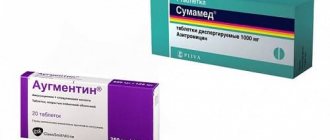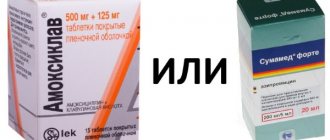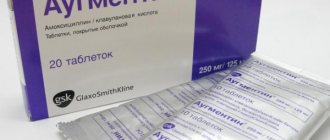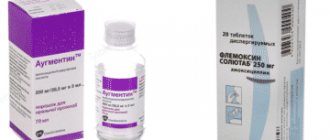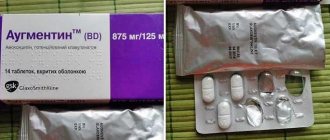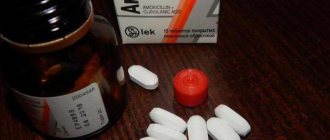Augmentin or Flemoxin Solutab: which is better and what is the difference (differences in compositions, reviews from doctors)
Antibacterial drugs, such as Augmentin or Flemoxin Solutab, are prescribed for diseases caused by bacterial infection. Depending on the subgroup, antibiotics destroy harmful microorganisms or prevent their growth and reproduction.
The spectrum of action depends on the activity of the main substance against a particular type of bacteria.
Some drugs are effective against a small number of strains of microbes, while others have a more universal effect and can be used for diseases caused by an unknown pathogen.
Characteristics of Augmentin
Augmentin belongs to the penicillin group of antibiotics with a wide range of effects. Active against many bacteria, aerobes and anaerobes. Prescribed for infections of the urinary and respiratory tract, skin and soft tissues.
Augmentin belongs to the penicillin group of antibiotics with a wide range of effects.
The drug contains amoxicillin and clavulanic acid. Amoxicillin promotes the destruction of cell membranes, which leads to the death of bacteria.
Sensitive to the action of beta-lactamase produced by some microbes and disintegrates under its influence.
Clavulanic acid, having a beta-lactam structure, ensures the resistance of amoxicillin to beta-lactamases and thus expands the spectrum of action of the drug.
Upon entering the body, Augmentin is quickly absorbed, distributed through the bloodstream in organs and tissues, destroying pathogenic microorganisms. Excreted in feces and urine.
Prescribed for the following diseases:
- upper and lower respiratory tract infections;
- dermatological diseases of an infectious nature;
- genitourinary system infections;
- sepsis;
- osteomyelitis;
- septicemia;
- inflammation of the peritoneum;
- postoperative infections.
Contraindicated in case of high sensitivity to the components included in the composition. It penetrates the placental barriers and is excreted in milk, so the use of the antibiotic during pregnancy (especially in the 1st trimester) and breastfeeding is not recommended.
Possible adverse reactions include diarrhea, nausea, vomiting, candidiasis of the skin and mucous membranes, headache, skin rash, itching.
The drug is available in the form of tablets, powder for making a suspension and powder for diluting a solution for intravenous administration. Doses are set individually, taking into account the location and complexity of the infection, the age and weight of the patient.
Unless otherwise prescribed, adults and children over 12 years of age for mild to moderate infections take 1 tablet (375 mg) 3 times a day. For severe infections, the dose can be doubled, but this decision can only be made by the attending physician.
How does Flemoxin Solutab work?
Flemoxin Solutab is an antibiotic from the group of semisynthetic penicillins with a high bactericidal effect. Active against many strains of pathogenic microorganisms, effective in the treatment of intestinal infections. Destroyed by bacteria that produce beta-lactamase.
The main active ingredient is amoxicillin, which disrupts the structure of the cell walls of microbes during their division and growth, thus contributing to the destruction of pathogenic microflora.
Flemoxin Solutab is an antibiotic from the group of semisynthetic penicillins with a high bactericidal effect.
When taken orally, the antibiotic is rapidly absorbed, metabolized and excreted primarily in the urine.
Flemoxin Solutab is indicated for infectious diseases of the following organs and systems:
- respiratory;
- urogenital;
- skin, soft tissues;
- gastrointestinal tract.
The antibiotic is contraindicated in case of individual intolerance to amoxicillin and other components of the drug.
Can be used to treat pregnant women as prescribed by a doctor and after assessing all the risks. Excreted in small quantities into breast milk, the risk to the baby is negligible, but sensitization to the drug may develop. If a newborn develops gastrointestinal disorders or allergic reactions, feeding should be stopped.
The drug can cause side effects such as nausea, vomiting, diarrhea, candidiasis of the skin and mucous membranes, dizziness, allergic reactions, hemolytic anemia, reversible leukopenia.
Flemoxin Solutab is available in tablet form. In the absence of other prescriptions, adults and adolescents weighing more than 40 kg take 500-700 mg of amoxicillin orally 2 times a day. The daily dose for children is calculated individually, taking into account weight and is divided into 3 doses.
Comparison of Augmentin and Flemoxin Solutab
Both drugs contain amoxicillin and are used to combat bacterial infections and inflammatory processes, but are not complete analogues and slightly differ in their spectrum of action, which must be taken into account when choosing a drug to achieve positive treatment results.
Similarities
Antibiotics belong to the group of penicillins and inhibit the activity of pathogenic microorganisms thanks to the active component - amoxicillin. Prescribed for infectious diseases of various systems and organs.
The drugs are characterized by high activity, good tolerability and are used to treat children. Can be used during pregnancy and lactation, but only as prescribed by a doctor in cases of extreme necessity and taking into account all risks. They have virtually no contraindications, with the exception of individual intolerance to the components included in the antibiotics.
What is the difference?
The main difference between the drugs is the composition. Augmentin has a universal effect due to the content of clavulanic acid, which ensures the antibiotic's resistance to enzymes that can destroy amoxicillin.
Unlike Augmentin, Flemoxin does not contain glucose, gluten and is suitable for patients suffering from diabetes.
Unlike Augmentin, Flemoxin does not contain glucose, gluten and is suitable for patients suffering from diabetes.
Antibiotics are used in pediatrics, but Flemoxin is more preferable due to fewer contraindications and adverse reactions, since it has a simplified composition and does not contain potassium clavulanate, which is highly allergenic.
Augmentin is available in several dosage forms. Flemoxin Solutab is available only in tablets.
Which is cheaper?
Antibiotics also differ in price. Flemoxin is cheaper than Augmentin, which is due to the presence of 2 active components in the latter and a wide range of indications for its use.
Which is better Augmentin or Flemoxin Solutab?
Augmentin is more versatile due to its resistance to enzymes that destroy amoxicillin, so its use is advisable for diseases caused by bacteria that produce beta-lactamase, as well as an unidentified pathogen.
In other cases, you can replace the drug with Flemoxin, which has an active effect, but does not contain clavulanic acid and is less allergenic.
To kid
Both antibiotics are used in pediatrics. For diseases whose pathogens are suppressed by amoxicillin, you can use Flemoxin, which has a more neutral composition. But only the attending physician can choose an effective drug for each individual case and calculate the correct dosage for the child.
Patient reviews
Igor M., 38 years old, Miass: “Augmentin was prescribed to the child by the pediatrician when the fever rose and signs of an upper respiratory tract infection appeared. The drug was taken in the form of a suspension. A day later, the temperature dropped, but we gave the medicine for 5 days.
The second child got sick - the symptoms are similar. The temperature could not be brought down within 4 days, on the second day of taking Augmentin it returned to normal, the other symptoms became less pronounced.
We didn’t do a microflora culture; the doctor prescribed an antibiotic, taking into account its versatility.”
Pavel B., 31 years old, Tatishchevo: “Our pediatrician prescribed Flemoxin for bronchitis. The tablet was dissolved in water and given to drink. The taste of the medicine turned out to be pleasant, so the child did not need to be persuaded.
The results appeared on day 2, but we took the entire course, because we had a sad experience with another drug, after which the disease returned a month later.
Flemoxin is an effective antibiotic and did not cause any adverse reactions.”
Lesya G., 28 years old, Vladivostok: “Several weak drugs turned out to be useless in the treatment of ARVI. The doctor prescribed the antibiotic Augmentin, because... Sinusitis also appeared.
But after taking 2 tablets in the morning, I developed severe weakness in my body, I could hardly stand on my feet, and diarrhea began. I had to treat not only a cold, but also dehydration and restore intestinal function.
Therefore, in my case, the drug did not work, I bought the package in vain.”
Augmentin is more versatile due to its resistance to enzymes that destroy amoxicillin.
Reviews from doctors about Augmentin and Flemoxin Solutab
Naumov A.A., dental surgeon with 8 years of experience, Lomonosov: “I consider Augmentin the best drug from the penicillin group.
It is effective for angina, treatment of respiratory diseases at an early stage, and has convenient release forms.
In my practice, I prescribe it to patients before surgical interventions to reduce the risk of postoperative complications. The disadvantages include the higher price compared to analogues.”
Nedoshkulo K.T., urologist with 20 years of experience, Rostov-on-Don: “Flemoxin Solutab is a high-quality and safe drug from a reliable manufacturer. May be prescribed during pregnancy. Rarely causes allergic reactions.
The antibiotic is characterized by a uniform release of the active substance, which ensures a more stable antibacterial effect.
Effective for inflammatory diseases requiring both therapeutic and surgical treatment.”
Source: https://SayDiabetu.net/lechenie/tradicionnaya-medicina/drygie-lekarstva/augmentin-i-flemoksin/
Characteristics of Augmentin
Augmentin belongs to the penicillin group of antibiotics with a wide range of effects. Active against many bacteria, aerobes and anaerobes. Prescribed for infections of the urinary and respiratory tract, skin and soft tissues.
Augmentin belongs to the penicillin group of antibiotics with a wide range of effects.
The drug contains amoxicillin and clavulanic acid. Amoxicillin promotes the destruction of cell membranes, which leads to the death of bacteria. Sensitive to the action of beta-lactamase produced by some microbes and disintegrates under its influence. Clavulanic acid, having a beta-lactam structure, ensures the resistance of amoxicillin to beta-lactamases and thus expands the spectrum of action of the drug.
Upon entering the body, Augmentin is quickly absorbed, distributed through the bloodstream in organs and tissues, destroying pathogenic microorganisms. Excreted in feces and urine.
Prescribed for the following diseases:
- upper and lower respiratory tract infections;
- dermatological diseases of an infectious nature;
- genitourinary system infections;
- sepsis;
- osteomyelitis;
- septicemia;
- inflammation of the peritoneum;
- postoperative infections.
Contraindicated in case of high sensitivity to the components included in the composition. It penetrates the placental barriers and is excreted in milk, so the use of the antibiotic during pregnancy (especially in the 1st trimester) and breastfeeding is not recommended.
Possible adverse reactions include diarrhea, nausea, vomiting, candidiasis of the skin and mucous membranes, headache, skin rash, itching.
The drug is available in the form of tablets, powder for making a suspension and powder for diluting a solution for intravenous administration. Doses are set individually, taking into account the location and complexity of the infection, the age and weight of the patient. Unless otherwise prescribed, adults and children over 12 years of age for mild to moderate infections take 1 tablet (375 mg) 3 times a day. For severe infections, the dose can be doubled, but this decision can only be made by the attending physician.
Which is better to choose Augmentin or Flemoxin Solutab?
Antibacterial drugs are usually prescribed for diseases that are caused by a bacterial infection. Antibiotics eliminate harmful microorganisms and block their development and growth, some of them are Augmentin or Flemoxin Solutab. Why is so much attention paid to these two drugs, because they are very similar in composition, but also have some differences.
What is special about Augmentin?
Augmentin in modern medicine is a well-known improved version of Flemoxin Solutab. This antibiotic is capable of affecting a variety of pathogenic organisms, even including classes of all bacterial enzymes. Augmentin also includes clavulanic acid and amoxicillin in its structure, which thereby gives such high resistance.
This drug is prescribed for the following diseases: bronchitis, pyelonephritis, blood poisoning, gonorrhea, osteomolitis, syphilis, postoperative infections, etc. Upon penetration into the body, Augmentin is immediately absorbed, sent with bleeding to tissues and organs, eliminating all pathogenic bacteria.
What is special about Flemoxin Solutab?
Flemoxin Solutab is the best antibacterial agent that has a huge range of applications. It consists of amoxicillin trihydrate. This is the same substance that has an active effect. Its main effect is the destruction of the destructive microenvironment .
Semi-synthetic penicillin is highly effective against more than a dozen positive and negative bacteria. Has weakly identified resistance to pathogens of intestinal infections.
Not absolute in relation to the type of bacterial components (beta-lactamase), the influence of which is directed towards resistance to penicillin.
The drug is used for infections caused by microflora that are sensitive to amoxicillin. Used in the treatment of: gastrointestinal tract, bacterial processes on the skin, urinary system and respiratory tract. Distinctive features of the medicine:
- Actively decomposes in the mouth.
- Stomach acid does not have the ability to influence it in any way.
- It has practically no ability to influence a group of bacterial microorganisms.
- The specific effects of the drug are felt after two hours of administration.
Similarities between Augmentin and Flemoxin Solutab
The most important and special similarity of these antibiotics is that they are classified as penicillins . They, in turn, delay the functioning of pathogenic microorganisms thanks to the main component - amoxicillin. They are used for infectious diseases of various systems and organs.
Also, the drugs are characterized by the highest activity, excellent tolerability and are used for the treatment of children.
They can be used during the gestation period and lactation, but only after a doctor’s prescription in specific cases of acute need and taking into account all possible risks to life.
In fact, they have no contraindications, if we take as an exception - personal intolerance to the elements that make up these drugs.
A person who is not well versed in medicine, at first glance, will not immediately be able to understand the insignificant difference between Augmentin and Flemoxin Solutab. Which of these drugs is better? This can be understood by which drug is preferred in various cases.
| Augmentin | Flemoxin Solutab | |
| By action | Has a huge range of influence on infectious microflora | Little effect on pathogenic microflora |
| For contraindications | - increased susceptibility to enzymes included in the components of the drug. - liver dysfunction. - gestation period and lactation. - allergy to the drug. | intolerance to penicillin and other auxiliary components |
| Security | There are a few more side effects | More loyal, because contains neutral and less allergenic enzymes |
| By price | Expensive | A little cheaper |
| By composition | - amoxicillin trihydrate. - clavulanic acid. | — amoxicillin trihydrate — vanillin — citrus flavors — cellulose — saccharin — magnesium stearate. |
| By release form | - tablets. - syrup. - in dry form, to be used as drops. - powder for injection. | Elongated tablets weighing from 100 mg to 1 g, white or yellow-white in color |
| Side effects | - urticaria. - Quincke's edema. - diarrhea. - candidiasis. - phlebitis. | - itching near the anus. - Quincke's edema. - skin allergies. - indigestion. |
The compared antibiotics are also suitable for use by children and have a good release form, but before use, it is necessary to prescribe the treating doctor so that he can individually choose the dosage. During the gestational period and lactation, Flemoxin Solutab is used only when the benefit for the woman from treatment is likely greater than the risk of deterioration in the fetus or child.
For children under 1 year of age, Augmentin is used in the form of drops. Before starting to take the drug, it will not hurt to find out the sensitivity of the microorganisms that caused the disease to it. It is difficult to say which of the compared drugs is better to choose in each special case; a specialist in his field can specifically answer this question.
Source: https://vchemraznica.ru/chto-luchshe-vybrat-augmentin-ili-flemoksin-solyutab/
How does Flemoxin Solutab work?
Flemoxin Solutab is an antibiotic from the group of semisynthetic penicillins with a high bactericidal effect. Active against many strains of pathogenic microorganisms, effective in the treatment of intestinal infections. Destroyed by bacteria that produce beta-lactamase.
The main active ingredient is amoxicillin, which disrupts the structure of the cell walls of microbes during their division and growth, thus contributing to the destruction of pathogenic microflora.
Flemoxin Solutab is an antibiotic from the group of semisynthetic penicillins with a high bactericidal effect.
When taken orally, the antibiotic is rapidly absorbed, metabolized and excreted primarily in the urine.
Flemoxin Solutab is indicated for infectious diseases of the following organs and systems:
- respiratory;
- urogenital;
- skin, soft tissues;
- gastrointestinal tract.
The antibiotic is contraindicated in case of individual intolerance to amoxicillin and other components of the drug.
Can be used to treat pregnant women as prescribed by a doctor and after assessing all the risks. Excreted in small quantities into breast milk, the risk to the baby is negligible, but sensitization to the drug may develop. If a newborn develops gastrointestinal disorders or allergic reactions, feeding should be stopped.
The drug can cause side effects such as nausea, vomiting, diarrhea, candidiasis of the skin and mucous membranes, dizziness, allergic reactions, hemolytic anemia, reversible leukopenia.
Flemoxin Solutab is available in tablet form. In the absence of other prescriptions, adults and adolescents weighing more than 40 kg take 500-700 mg of amoxicillin orally 2 times a day. The daily dose for children is calculated individually, taking into account weight and is divided into 3 doses.
What is the difference: Flemoxin Solutab and Augmentin
Augmentin and Flemoxin Solutab are antibacterial drugs used in the treatment of many infectious diseases with different localizations of foci.
Augmentin and Flemoxin Solutab are antibacterial drugs used in the treatment of many infectious diseases with different localizations of foci.
Brief characteristics of Augmentin
Belongs to the pharmacological group of penicillins. Active ingredients: amoxicillin sodium and clavulanic acid.
Release forms: tablets, powder, on the basis of which an injection solution is prepared, and powder for preparing a suspension.
The mechanism of action is based on the effect of amoxicillin sodium on bacterial pathogens, which inhibits their vital processes at the cellular level. Amoxicillin is sensitive to beta-lactamase produced by pathogenic microflora. Clavulanic acid protects amoxicillin from degradation, due to which the spectrum of action of the antibiotic is greatly expanded.
Indications for use of tablet form and antibiotic suspension:
- community-acquired pneumonia;
- sinusitis in the acute stage;
- otitis media;
- chronic bronchitis during exacerbation;
- pyelonephritis;
- cystitis;
- infectious skin diseases, including those caused by insect and animal bites;
- infectious cellulitis;
- stomatitis.
An antibiotic in the form of a solution is prescribed in identical clinical cases, but occurring with complications and severe, intense symptoms.
Contraindications:
- hypersensitivity to any of the components;
- the presence of an allergic reaction to antibiotics from the penicillin group;
- jaundice or abnormalities in kidney function caused by taking penicillin antibiotics.
Augmentin should not be taken during the 1st trimester of pregnancy. In 2 and 3 it can be prescribed if there are special indications for this, if the positive result outweighs the risks of complications. The medication is prohibited during breastfeeding.
The doctor determines the dosage individually depending on the age and weight of the patient and the form of the antibiotic. The average course duration is 2 weeks. For adults, it is preferable to use tablets and an injection solution; in pediatrics, it is preferable to use a suspension.
Possible side effects:
- Convulsions, headaches and attacks of dizziness, hyperactivity.
- Gastrointestinal tract: diarrhea, nausea and vomiting, development of cholestatic jaundice, inflammation of the walls of the colon.
- Skin: itching and rashes, urticaria, bullous type dermatitis.
An overdose is manifested by nausea and vomiting, deterioration of the general condition. There is no specific antidote. Treatment is symptomatic and involves cleansing the stomach and taking sorbents.
An overdose of Augmentin is manifested by nausea and vomiting, deterioration of the general condition.
Brief characteristics of Flemoxin Solutab
Release form: tablets. The active ingredient is amoxicillin trihydrate. The mechanism of action is the ability of the active component to penetrate the membrane of pathogen cells and inhibit biochemical processes, which leads to their death.
The use of the drug is recommended in the following cases:
- infectious diseases of the upper and lower respiratory system, accompanied by inflammatory processes;
- for infections of the genitourinary system;
- damage by an infectious pathogen to the skin and soft tissues.
In combination with other medications, it helps fight diseases of infectious origin of the digestive tract.
Contraindications:
- intolerance to certain components;
- infectious type mononucleosis;
- peptic ulcer of the duodenum or stomach;
- renal failure;
- pregnancy, breastfeeding period.
Dosage: from 500 to 750 mg, taken 1 to 3 times a day, depending on the severity of the pathology.
The antibiotic is well tolerated, the likelihood of adverse symptoms occurring if the dosage is observed and there are no contraindications is minimal.
However, the following undesirable reactions may occur:
- violation of taste perception;
- digestive system disorders: nausea and vomiting, diarrhea;
- Skin allergies: rash, redness and hives.
Rarely, due to hypersensitivity to the active ingredients, angioedema and anaphylactic shock may occur.
An overdose is manifested by severe nausea and profuse vomiting, diarrhea. No antidote has been developed. Treatment consists of removing remnants of the drug from the body by gastric lavage and further use of sorbents, for example, activated carbon. If necessary, symptomatic therapy is carried out.
In combination with other medications, Flemoxin Solutab helps fight diseases of infectious origin of the digestive tract.
Comparison of Flemoxin Solutab and Augmentin
There are both similarities and differences between the drugs, the analysis of which allows you to make the right choice.
What is the difference
There are many differences between antibacterial drugs:
- The difference between the compositions: Augmentin, in addition to amoxicillin, has clavulanic acid, which protects the active component from the destructive effects of beta-lactamase, which expands the range of its use.
- Augmentin has more contraindications.
- The number of side effects and the frequency of their occurrence are higher with Augmentin. Flemoxin is safer and gentler on the body.
- Release forms: Flemoxin is available only in tablet form, but Augmentin also has powders for preparing an injection solution and suspension.
- The auxiliary components differ, but they do not have a special effect on the pharmacology of the drugs, so this difference is considered insignificant.
Which is cheaper?
The price of Augmentin is from 140 to 1800 rubles, Flemoxin is from 230 to 500 rubles.
Is it possible to replace Augmentin with Flemoxin Solutab?
1 antibiotic can be replaced by another if the clinical case allows it. Considering the absence of clavulanic acid in Flemoxin, it can replace Augmentin only if the pathogenic microflora that provoked the infectious process does not produce beta-lactamase.
Which is better – Flemoxin Solutab or Augmentin
It is impossible to answer which product is better - Flemoxin Solutab or Augmentin. Both drugs show high effectiveness in the treatment of infectious pathologies. But a number of differences allow you to choose a drug depending on the course of the disease.
It is preferable to give Augmentin to a child in the form of a suspension. Despite the fact that Flemoxin is a safer antibiotic, its tablet form is inconvenient for use by children.
Augmentin, although more effective in treating infections, is more toxic and more likely to cause adverse reactions. In this regard, if the clinical case allows, it is recommended to take the softer and safer Flemoxin.
Doctors' opinions and patient reviews
Diana, 52 years old, pediatrician, Ryazan
In pediatrics, both antibiotics are used with equal effectiveness. Augmentin is preferable because it is easy to give in the form of a powder for the preparation of a suspension to young children who are not yet able to take the tablet form. Despite the fact that Flemoxin is considered a milder antibiotic, the likelihood of side effects for both drugs is at the same level.
Evgeniy, 41 years old, therapist, Nalchik
Augmentin contains clavulanic acid, which protects amoxicillin from destruction under the influence of beta-lactamases, making its scope of application much wider.
Flemoxin has more limited indications for use; it is recommended to take it for mild infections.
But both drugs are effective and, if the rules and regimen are followed, are well tolerated without causing negative reactions.
Zhanna, 39 years old, therapist, Izhevsk
Flemoxin and Augmentin show high effectiveness in the treatment of infectious diseases.
Augmentin, due to the presence of clavulanic acid in its composition, is considered more effective, but at the same time more toxic.
If the disease allows, preference should be given to the safe and non-toxic antibiotic Flemoxin. Only a doctor should prescribe the drug depending on the type of bacterial microflora.
Natalya, 37 years old, Moscow
My daughter often suffers from bronchitis, and Augmentin in suspension for children always saves us. The antibiotic quickly relieves the symptoms of the disease, is easily tolerated, without causing side symptoms. I had experience taking Flemoxin.
But, firstly, it is inconvenient to give it to a child, and secondly, it is not so effective. It helped cure bronchitis, but it took longer than Augmentin.
The only drawback of the latter is the high price, but it's worth it.
Svetlana, 31 years old, Perm
Augmentin caused side effects for me: nausea and headaches. And Flemoxin helped quickly and was easily accepted by the body without any negative manifestations. In addition to being well tolerated and highly effective, Flemoxin is several times cheaper.
Source: https://prostatit.expert/preparati/v-chem-raznitsa-flemoksin-solyutab-i-augmentin.html
How does Flemoxin Solutab work?
The drug Flemoxin Solutab belongs to the group of penicillins. The manufacturer offers one dosage form - tablets, which can be taken in any convenient way (swallowed, chewed or dissolved in water to prepare syrup).
Oval tablets are white or cream in color. The dosage may vary (from 125 mg to 1000 mg).
The drug Flemoxin Solutab contains only 1 main substance - amoxicillin. In the list of additional components:
- magnesium stearate;
- dispersible cellulose;
- crospovidone;
- MCC;
- lemon and tangerine flavoring;
- vanillin;
- saccharin.
The drug is active against many microorganisms, including both gram-positive and gram-negative.
Flemoxin Solutab is active against both gram-positive and gram-negative microorganisms.
The following strains are immune to penicillin:
- Proteus spp.;
- Pseudomonas spp.;
- Enterobacter spp.;
- Serratia spp.
The list of diagnoses for which Flemoxin Solutab is prescribed:
- infectious diseases of the respiratory system;
- diseases of the genitourinary system caused by bacteria;
- inflammatory processes in soft tissues and skin;
- diseases of the gastrointestinal tract that are infectious in nature.
Before prescribing this drug, the causative agent of the disease should be identified. If the pathogenic organism is not sensitive to penicillin, then therapy will be useless.
The tablets have several contraindications:
- intolerance to the components included in the medicine;
- individual sensitivity to beta-lactam antibiotics;
- Infectious mononucleosis;
- renal failure;
- lymphocytic leukemia
During pregnancy and lactation, the drug is prescribed with caution and taken under the strict supervision of a doctor.
In some cases, side effects may occur:
- attacks of nausea with vomiting, changes in taste, diarrhea, hemorrhagic colitis (extremely rare);
- interstitial nephritis;
- thrombocytopenia, neutropenia, hemolytic anemia, agranulocytosis;
- If allergic reactions occur, a rash, exudative erythema, angioedema, and anaphylactic shock may appear.
The drug can be prescribed to children from 3 years of age. Doses and dosage regimen are prescribed by the doctor depending on the diagnosis and age of the patient.
What is the difference
Despite the similarity of the active composition, Flemoxin and Augmentin have several differences:
- Augmentin is different in that it is a combination drug: it also contains clavulanic acid. Due to this, the active effect of this medicine is wider than that of Flemoxin.
- Contraindications. Amoxicillin with clavulanic acid has a wider list of contraindications, including liver and kidney diseases.
- Side effects. Flemoxin causes side effects less often, and their list is much smaller.
- Release form. Augmentin has tablet and powder forms, while Flemoxin is only available in tablets.
What is better - Augmentin or Flemoxin Solutab?
In order to choose the most effective drug for adults, the doctor must conduct an examination and study the test results. The medicine is selected individually.
Most often, for moderate disease, Flemoxin is prescribed, and in more severe cases, Augmentin.
Augmentin or Flemoxin Solutab: which is better and what is the difference between the drugs
In the debate about Augmentin or Flemoxin Solutab - which is better - strong arguments are needed. The choice depends on the diagnosis, the specifics of the situation, even the qualifications of the attending physician.
Of course, the decision is made by the therapist or pediatrician, but patients should have information about the strengths and weaknesses of the drugs, their characteristics.
Familiarization with the annotation is clearly not enough; help from competent sources will be required.
What is special about Flemoxin Solutab?
The drug is manufactured by the Dutch company Astellas Pharma Inc.
Designed to suppress the activity of bacteria, pathogens of pulmonary diseases, genitourinary organs, gastrointestinal tract, and treatment of skin diseases.
The active substance, amoxicillin, belongs to the group of semisynthetic penicillins. Release form: yellowish tablets, with 250, 500, 1000 milligrams of the main component.
Features of Augmentin
The product of the British manufacturer is Smith Klein Beecham Limited. Clavulanic acid is added to amoxicillin, together they are effective against various infections of the respiratory tract, urinary and genital organs. One tablet contains 500 (875) milligrams of amoxicillin and 125 milligrams of potassium clavulanate.
Comparison of drugs
Taking into account the fact that both drugs “work” in the same area of application and treat the same diseases, they will certainly have common features. But there may also be differences.
What are the similarities?
Of course, this is the main pharmacological component - amoxicillin. Refers to synthesized penicillin containing and similar compounds.
Known as an effective “inhibitor” of various infectious microorganisms that live in the respiratory tract, lungs, kidneys, genitals, skin and soft tissues of humans.
Amoxicillin is used to treat chronic diseases, with which it copes well.
Only Augmentin has this substance supplemented with one more. Another important advantage is that this choice allows you to target and fight bacteria that can resist penicillins. The drug will be even more suitable for patients with a known allergy to the penicillin component.
Difference between means
Even if drugs from different manufacturers have similar features, there will always be characteristic differences. For clarity and ease of perception, they are presented in tabular form:
| Differences | Drug name | |
| Flemoxin | Augmentin | |
| Action | Average for pathogens | Suppression of heterogeneous infections |
| Contraindications | Weak susceptibility to penicillin and other components | Negative reaction to medication, allergic manifestations |
| Available in the form | Tablets (white, yellowish) | Tablets and suspension, powder |
| Possible side effects | Irritation of the anus, inflammation of the skin, Quincke's edema, gastrointestinal upset | Indigestion, candidiasis, urticaria, Quincke's edema |
With all the stated differences, doctors successfully combine the use of one drug or another, taking into account the patient’s specific reactions and the nature of the disease.
Is it possible to replace one drug with another?
When comparing and choosing drugs, you should remember that self-medication is dangerous to health. The decision to prescribe medications is made by the doctor, not the patient, at his own discretion. When trying to find a balance between these medications, take into account that the effect of Flemoxin is milder than that of Augmentin.
If the first medicine is ineffective, it is allowed to replace it with a second one. At the same time, sometimes the “augmentin” drug is considered an “improved” version of Solutab, which has an enhanced reaction to hostile microflora. The reverse switch (from Augmentin to Flemoxin) must be justified, otherwise aggressive microorganisms will have a chance to continue their harmful activity.
Which is better to choose?
The decision to choose a drug may be based on the following arguments:
- the patient has contraindications;
- age (a particular medication may not be suitable for children);
- allergic reactions to medications, their components;
- cost (it differs depending on the form of release, brand of the drug);
- reviews from “testers”, opinions and recommendations of the attending physician.
Flemoxin is cheaper, but weaker. Augmentin is available in powder, drops and syrups, this also works as an argument in a certain situation. Which of the arguments turns out to be weighty and final is up to the person being treated to decide.
And you definitely need to coordinate the use of Flemoxin or Augmentin with your local doctor, especially for young patients.
By action
Despite the presence of a common component - amoxicillin - it works differently in medications. Flemoxin does not suppress various infections and acts selectively on them. Augmentin has a wider spectrum, so it is prescribed to get rid of the presence of hostile microorganisms that disrupt the functioning of the respiratory system and have settled in the urinary tract and genitals.
If we find what we need in the list of diseases listed in the annotation, we choose Flemoxin without the slightest doubt. A complex effect is required - it is better to give preference to Augmentin.
For contraindications
Any drug has contraindications. In the case of Flemoxin, there are few of them, mainly due to the patient’s intolerance to penicillin-containing components. Augmentin pills or drops, in addition to an allergic reaction, should not be used if the patient is diagnosed with liver dysfunction or excessive sensitivity to the components of the drug.
And this argument can be decisive. Why put yourself and your loved ones at risk and risk your health? The dilemma between Augmentin and Flemoxin tablets can be radically resolved in favor of the latter, since the manufacturers of Solutab managed to minimize allergic reactions and side effects. Regarding Augmentin, there are, unfortunately, more of them.
By price
The cost of Flemoxin ranges from 245 (minimum dosage, 125 milligrams) to 361 rubles (500 milligrams). For Augmentin you will have to pay between 128 (suspension, 156 milligrams of active substance, 100 milliliter bottle) - 642 rubles (tablet form, 1000 milligrams). Treatment costs also include the duration of the course and the appointment prescribed by the doctor.
By composition
If we discard the other components, then the fundamental component in both drugs is the same - amoxicillin. In Flemoxin it is supplemented with additives to improve taste (sugar, citrus, vanilla), and in Augmentin it is supplemented with clavulanic acid. Tolerability of the drugs is satisfactory, but suspensions are more suitable for young patients.
